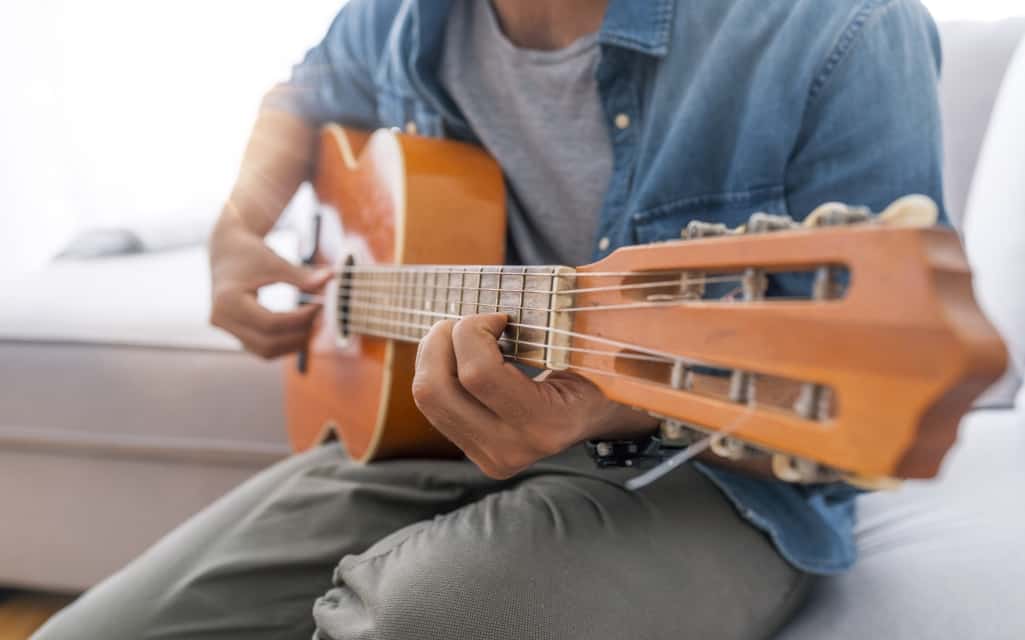If you look at some of the best guitar players around the world, no matter whether they play heavy rock or classical tunes, all of them have one thing in common – good technique. It might be challenging at first when you learn how to play guitar, though the easiest way is to make your practice time as much productive as possible. This primarily includes where you practice, when you practice, and what you practice while setting your music goals. If you are taking home guitar lessons, we have compiled some of the most effective techniques to help you get proficient in no time. To know more about best guitar picks and accessories to help you become a better guitar player read this blog post.
1 Evade The Left-Hand Death Grip
When you are playing guitar for the very first time, you may find that pressing the strings can hurt your fingers. One efficient way to overcome this is by securing your thumb over the top of the fretboard. It will allow you to press the strings with a much smooth pad of your finger instead of the actual fingertip. This is commonly known as death grip since it restricts your finger while putting pressure on your neck. For this, make sure to keep your thumb on the back of the guitar’s neck. By doing this, you will be using your fingertips in a more accurate way to play those beautiful notes.
2 Do Not Speed Up
Do not hurry in your learning process. It’s more about accurate fingering and thumping the right notes each time specifically when it comes to scales and playing complex bar chords. Emphasize on precise fingering and it will eventually improve your speed. Make sure to invest sufficient time and play slowly. You may use Uberchord Guitar App as it listens to you while you are practicing and corrects when you play wrong. It’s FREE!
3 Use A Metronome
Playing to a click track is a tough job, though the benefits it offers are endless. Your sense of beat and duration will be certainly enhanced as soon as you try using a metronome. All you have to do is set the right beats per minutes and play in time. You will find several metronome apps on the internet. Practice!
4 Be Well-organized with Your Practice
The master technique of all is to put your hands on the guitar and practice the lessons. Even if you are too busy or tired, take out 15 minutes for the learning session. Try to invest some time on an everyday basis and develop good and consistent playing habits. You may use an application to set your daily or weekly goals. It will help you track your progress and remind you if you become lazy or lose your focus.
5 Give Yourself a Break
One important factor is not to push yourself too hard in the beginning. As soon as your muscles start to squeak and the fingertips are hurting, take a break and relax. If not, you will perhaps damage your muscles and tendons. Keep in mind that you need rest to keep efficient and consistent.
6 Don’t Overlook Your Right-Hand Practice
At times, it is good to mute the strings with your left hand and start practicing using the right-hand strumming. You may want to use an easy chord and focus more on finger-picking that you are learning. That way, you may ignore the use of your right hand. Remember that learning how to play guitar is a two-handed task. Work hard on your basics and proper technique for the beginning learning sessions and soon you will become a great player.
7 Always Use Correct Fingering
Over the years, many guitar specialists have figured out the most efficient way to play chords and scales is using the correct fingers on the fretboard. Sometimes you may explore an easier way of playing these, but don’t be overwhelmed. Correct fingering isn’t merely about playing the chord or scale, rather it involves several variations from the custom style of fingering to sevenths and ninths. Make sure that you pay careful attention to correct fingering and your hand’s position is accurate on the fretboard. Apply all those basic requirements when playing guitar and enjoy!



